
Recommended Focusing Screens
Various interchangeable focusing screens are available for Nikon
F3-
and F2-series cameras
to suit any
type
of lens or picture-taking situation. Those which
are
recommended for
use
with
this lens are listed
below.
For screens used with Nikon cameras other than F3-and F2-series
cameras (e.g., Nikon
FA,
FE2, FM2 and
FE),
refer to the columns for F3-series cameras. For
the
K2,
B2
and
E2
focusing
screens,
refer
to the columns on
the K,
B
and
E
screens,
respectively.
For details, also refer to the specific focusing screen's instruction sheet.
c^?r--§£!!^
F3
F2
A/L
®
•
B
0
©
c
o
o
D
o
0
E
©
©
G1
G2 G3
G4
H1 H2 H3
H4
J
®
m
K/P
®
®
M
R
®
«
T U
®@
• When the Teleconverter TC-301 or TC-300 is attached to this lens, use the following
table*:
Ca^?r-^£reCT
F3
F2
A/L
®
®
B
©
©
C
D E
©
©
G1
G2 G3
G4
H1
H2 H3 H4
J
S
®
K/P
®
®
M
R
®
•
T
U
®@
• When the Teleconverter TC-14B or TC-14 is attached to this lens, use the following
table**:
Ca^ra^-^
F3
F2
A/L
®
®
B
©
©
C
o
o
D
o
o
E
©
s
G1 G2 G3 G4 H1 H2 H3
H4
J
®
•
K/P
®
®
M R
9
®
T U
®©
* To attach the TC-301 or TC-300 to the lens, filter shouuld first be detached.
** To attach the TC-14B or TC-14 to the lens, filter should first be detached.
©= Excellent focusing
®= Acceptable focusing
The image is brilliant from edge to edge, but the center area (range-finder, micro-
prism or corrs-hair) is dim. Focus on the surrounding matte area.
Q = Acceptable focusing
Slight vignetting (or moire phenomenon, in the case of the microprism) affects the
screen image. The image on the film, however, shows no trace of this.
Blank means inapplicable.
9


















